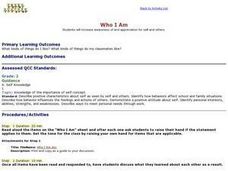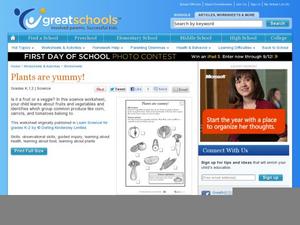Curated OER
Who I Am - Likes
Second graders complete a "Who Am I" sheet to decide what kinds of things they like and then have a class discussion.
Curated OER
Causes and Effects of the Civil War
Fifth graders identify the causes and effects of the Civil War. They use Inspiration Software.
Curated OER
"How Do You Measure Up?"
Fourth graders explore basic measurements by analyzing their own bodies. In this human anatomy lesson, 4th graders identify the units used to measure a human body such as centimeters, inches, ounces and pounds. Students complete a...
Curated OER
Making Inferences While Identifying Similes and Metaphors
Use this lesson to study similes and metaphors and the inferred meaning. In this language arts lesson, 5th graders write their own similes and metaphors. A worksheet is provided for extension work or to check understanding as homework.
Curated OER
Using the Internet to Challenge Young Writers
Designed as a professional development exercise to introduce teachers to the Internet, the activities in this resource ask novice web surfers to access a series of sites, bookmark them, and answer question about information found on the...
Curated OER
Note Taking
Third graders get ready to take notes on a field trip. In this notetaking lesson, 3rd graders take notes to remember what they've seen on a field trip. Students draw and analyze diagrams of what they have seen. Students access their...
Curated OER
Living Amendments to Our Constitution
Students review the articles of the Constitution and identify the amendments to the Constitution. They use the skills of analysis and synthesis in matching the present day situation with the correct Amendment that applies.
Curated OER
Road To Roota
Did you know that there are comic books that can help learners discover economic concepts like supply and demand. The format of this lesson is highly engaging and enables them to discover how economics can be an exciting field of study....
Curated OER
Can You See What I See?
Students gain an understanding of the methods used to explore the earth's surface. Students create a time line leading to the first satellite image of the Earth that includes the various methods utilized to observe the earth's surface.
Curated OER
Asking Research Questions
Using discoveries and inventions as the focus, learners complete a research project. First, they come up with research questions. Then, they conduct research on the topic. Finally, they write a research paper.
Curated OER
Was it Fair for the Elephant's Child?
Learners use literature to explore ideas of justice. They discuss what makes something fair or unfair. They draw and explain cartoons that tell the story.
Curated OER
Getting Into Shapes: Identifying and Describing Two-Dimensional Shapes
Young scholars examine their classroom to find examples of various types of shapes. After identifying and describing the various shapes, they draw as many as they can on a piece of paper. They organize them into an image based on their...
Curated OER
Plants are yummy!
Is it a fruit or a vegetable? Youngsters place an F next to each fruit they see and a V next to the vegetables. Corn is tricky. It is a grass, so it's actually not a fruit or a vegetable, but a grain!
Curated OER
Recycling & Our Environment
Students present information about recycling to other students. In this environmental protection lesson, students create a puppet show or commercial about the importance of recycling for other students to view.
Curated OER
Shapes and Colors All Around
Students tour their school in a scavenger hunt to find primary colors and two and three-dimensional shapes. Students take digital pictures of the colors and shapes they find and create a class book of the pictures.
Curated OER
Imaginative Interpretations
Students explore how works of art can be inspired by stories by creating their own work of art inspired by a narrative text.
Curated OER
Patterns in Nature
Students examine places in nature where patterns can be observed by looking through a number of books after watching a teacher PowerPoint presentation. They illustrate a pattern in nature.
Curated OER
Looking at Life through the Creation of Personal Metaphors
Young scholars focus on the creation of personal metaphors, which are first illustrated in pictures and caricatures and then extended to descriptive/analytical paragraphs. They teach the lesson to others using their own personal...
Curated OER
Building a Mini-Park and Bird Sanctuary
Students build a list of gardening vocabulary from prior knowledge of gardens. In this gardening lesson, students understand the importance of gardens to humans and animals for food, shelter, and air. Students discuss the garden in...
Curated OER
Color in Paintings
Students examine the color in paintings. In this visual arts lesson, students explore the 1821 painting by Jacques-Louis David and identify the colors in the art piece. Students write an original fairy tale and create an illustration...
Curated OER
Farming Number 6
In this environment worksheet, students identify and explain the importance of water and farming. They identify the differences between food items and whether they are a fruit, vegetable, or animal. Students also respond to 5 yes/no...
Curated OER
Science: Bees: An Interdisciplinary Approach
Young scholars investigate the world of bees and describe their characteristics. by identifying the bees' parts, they demonstrate how these parts function. In the lab, students dissect bees and view the various parts under microscopes....
Curated OER
Electrifying Franklin
Fourth graders research and present information about Benjamin Franklin's life and accomplishments. For this lesson on Benjamin Franklin, 4th graders review idioms and sayings written by Franklin then compare and contrast his various...
Curated OER
Weather Reporter
Fourth graders generate an oral presentation on the weather. In this weather lesson, 4th graders watch the weather for a week and record the data on a chart. Students give a weather report at the end of the week.

























